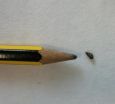(Press-News.org) PHILADELPHIA, Aug. 22, 2012 — Camouflage face makeup for warfare is undergoing one of the most fundamental changes in thousands of years, as scientists today described a new face paint that both hides soldiers from the enemy and shields their faces from the searing heat of bomb blasts. Firefighters also could benefit from the new heat-resistant makeup, according to the report.
It was part of a broader symposium on innovations in ingredients for personal care products held during the 244th National Meeting & Exposition of the American Chemical Society, the world's largest scientific society. The meeting, which includes almost 8,600 reports on new discoveries in science and other topics, continues through Thursday. The other reports (abstracts appear below) included new hairsprays, mousses, denture adhesives, tartar-control toothpastes, mouthwashes and personal cleansing products.
Robert Lochhead, Ph.D., who presented the report, explained that soldiers have used face paint for centuries for one kind of protection ― to help their skin blend in with the natural environment and shield them from enemies. The new material continues that tradition, but also provides protection from the searing heat of roadside bomb blasts and other explosions that have claimed a terrible toll in Iraq, Afghanistan and other conflicts.
"The detonation of a roadside bomb or any other powerful explosive produces two dangerous blasts," Lochhead said. "First comes a blast wave of high pressure that spreads out at supersonic speeds and can cause devastating internal injuries. A thermal blast follows almost instantaneously. It is a wave of heat that exceeds 1,112 degrees Fahrenheit. That's as hot as a burning cigarette. The thermal blast lasts only two seconds, but it can literally cook the face, hands and other exposed skin."
In an effort to protect soldiers from this threat, the U.S. Department of Defense has been seeking a solution that Lochhead initially regarded as an impossibility: A material that soldiers could smear on their faces like suntan lotion, leaving a coating that although thinner than a sheet of paper, could protect against that intense heat. Dr. Paige Buchanan, Kelli Booth, Michelle McClusky, Laura Anderson and Lochhead were the team that tackled the challenge. Not only did they succeed, but they discovered a formulation that protects in laboratory experiments way beyond the 2-second heat-wave threat from improvised explosive devices and other bombs.
The new camouflage makeup protects the face and hands for up to 15 seconds before its own temperature rises to the point where a first-degree burn, which is a mild burn, might occur. In some tests, the new face paint can protect for up to 60 seconds, which could be important in giving soldiers time to move away from blast-related fires and also for use by civilian firefighters.
The makeup had to meet several key criteria: It had to reflect intense heat; have camouflage colors suitable for day and night use; be easy to apply and remove; be waterproof; and be non-irritating to the eyes, nose and mouth.
The trickiest part was that the University of Southern Mississippi team had to avoid the use of mineral oil, mineral spirits, fatty substances and other traditional hydrocarbon makeup ingredients. Hydrocarbons can burn in contact with intense heat in the flame spectrum. The team turned to silicones, which are not as flammable because they absorb radiation at wavelengths outside of the intense heat spectrum. Silicones have been replacing hydrocarbons in many commercial cosmetic makeup products as cosmetics companies improve products to confer better feel properties and transfer-resistance.
Another challenge was adding DEET, an insect repellent. The military mandates that all camouflage makeups contain 35 percent DEET. "DEET also is flammable, so when the Department of Defense asked us to incorporate it, we didn't think we could do it," Lochhead noted. But the team successfully included DEET by encapsulating it in a hydrogel substance, a water-rich material that prevented DEET from catching fire.
It already has passed the preliminary laboratory tests needed to determine whether development should continue. Lochhead's team also plans tests of the material on other surfaces to try to protect clothing, tents and other items from burning, and a colorless version is being developed for firefighters.
INFORMATION: END
New era in camouflage makeup: Shielding soldiers from searing heat of bomb blasts
2012-08-22
ELSE PRESS RELEASES FROM THIS DATE:
Researchers find benefits to early intervention in addressing brain abnormalities
2012-08-22
Preemptive cognitive training—an early intervention to address neuropsychiatric deficiencies—can help the brain function normally later in life, a team of researchers has found through a series of experiments on laboratory rats. Their findings, which appear in the latest issue of the journal Neuron, hold promise for addressing a range of brain impairments in humans, including schizophrenia.
The study was conducted by researchers at New York University's Center for Neural Science, the State University of New York (SUNY) Downstate Medical Center, NYU Langone Medical Center, ...
With a little training, signs of schizophrenia are averted
2012-08-22
Animals that literally have holes in their brains can go on to behave as normal adults if they've had the benefit of a little cognitive training in adolescence. That's according to new work in the August 23 Neuron, a Cell Press publication, featuring an animal model of schizophrenia, where rats with particular neonatal brain injuries develop schizophrenia-like symptoms.
"The brain can be loaded with all sorts of problems," said André Fenton of New York University. "What this work shows is that experience can overcome those disabilities."
Fenton's team made the discovery ...
Lawson researcher sings the baby blues
2012-08-22
LONDON, ON – The impact of bipolar disorder during pregnancy has been hotly contended among the research community. Now, a new study from Lawson Health Research Institute and Western University is sorting out the debate and calling for more targeted, prospective research.
Bipolar disorder is characterized by depression, hypomania, or mania. It is most common among women, and its episodes are often concentrated during the height of the reproductive years.
Bipolar disorder can lead to suicide, infanticide, and increased risk for psychiatric hospitalization during the ...
MMV develops framework to assess risk of resistance for antimalarial compounds
2012-08-22
Medicines for Malaria Venture has developed a framework to evaluate the risk of resistance for the antimalarial compounds in its portfolio. A paper based on this work: A framework for assessing the risk of resistance for antimalarials in development has been published in the Malaria Journal today.
Resistance defines the longevity of every anti-infective drug, so it is important when developing new medicines for malaria, to check how easily promising antimalarial compounds will select for resistance. Once this is known, it facilitates the prioritization of not only the ...
More sophisticated wiring, not just bigger brain, helped humans evolve beyond chimps
2012-08-22
Human and chimp brains look anatomically similar because both evolved from the same ancestor millions of years ago. But where does the chimp brain end and the human brain begin?
A new UCLA study pinpoints uniquely human patterns of gene activity in the brain that could shed light on how we evolved differently than our closest relative. Published Aug. 22 in the advance online edition of Neuron, these genes' identification could improve understanding of human brain diseases like autism and schizophrenia, as well as learning disorders and addictions.
"Scientists usually ...
Lack of food increases hospital use by HIV-infected urban poor in SF
2012-08-22
UCSF researchers found that poor HIV-infected individuals living in San Francisco are significantly more likely to visit emergency rooms and to have hospital stays if they lack access to food of sufficient quality and quantity for a healthy life.
"In the prior three months, a quarter of participants in the study reported an ER visit, and just over a tenth reported a hospitalization, which shows that we are dealing with a population with high levels of illness. But the food insecure people were even sicker than the food secure, which is consistent with their experiencing ...
Green tea compound shows promise for tackling cancer
2012-08-22
A compound found in green tea could be a weapon in treatments for tackling cancer, according to newly-published research at the University of Strathclyde in Glasgow, Scotland.
The extract, known as epigallocatechin gallate, has been known to have preventative anti-cancer properties but fails to reach tumours when delivered by conventional intravenous administration.
However, in initial laboratory tests at the Universities of Strathclyde and Glasgow, researchers used an approach which allowed the treatment to be delivered specifically to the tumours after intravenous ...
Glass offers improved means of storing UK's nuclear waste
2012-08-22
ILW makes up more than three quarters of the volume of material destined for geological disposal in the UK. (1)
Currently the UK's preferred method is to encapsulate ILW in specially formulated cement. The waste is mixed with cement and sealed in steel drums, in preparation for disposal deep underground.
Two studies, published in the latest issues of The Journal of Nuclear Materials and European Journal of Glass Science and Technology A show that turning this kind of waste into glass, a process called vitrification, could be a better method for its long-term storage, ...
Losing stream in our battle to predict and prevent invasive species
2012-08-22
Invasive species – plants, animals, and microbes introduced to regions beyond their native range – carry a global price tag of $1.4 trillion dollars. They are responsible for the loss of natural resources and biodiversity, damages to infrastructure, and an uptick in infectious diseases.
Not all non-native species pose a threat. Scientists around the world have spent the last several decades teasing apart the conditions that set the stage for debilitating invaders, like giant hogweed, zebra mussels, or gray squirrels. A number of hypotheses have emerged to help predict ...
Survival without water: A key trait of an aquatic invader to spread
2012-08-22
Nowadays, an increasing number of rivers and lakes are being invaded by exotic snails, which come from remote regions, and even other continents. Such species represent a threat to native species, as they compete for food or space with them.
This is the case of the mudsnail Potamopyrgus antipodarum. This small aquatic snail is native to New Zealand, and has spread throughout rivers, lakes or streams in Europe, Australia, America and Asia. The invasion success of this mudsnail may be partly due to the ability of females to reproduce without participation of males (i.e. ...



